
Industry Insights
The Utility’s Guide to Microgrids
As the energy sector navigates the transition to a more sustainable and resilient grid, microgrids are proving to be invaluable assets for utilities. These localized energy systems offer a dynamic solution to integrating renewable energy, enhancing grid reliability and improving operational efficiency. In this blog, I dive into the role and capabilities of microgrids and how utilities can harness their potential to create a more resourceful future.
What are Microgrids?
Microgrids are a pioneering concept in energy distribution and management, characterized by small-scale, localized power systems that can function independently or alongside the main electrical grid. Unlike traditional centralized grids, microgrids are designed to serve specific areas or facilities, such as hospitals, neighborhoods, campuses, military bases or remote locations.
How do Microgrids Work?
Microgrids are self-contained energy systems that can operate independently or in conjunction with the main power grid and are largely comprised of distributed energy resources (DERs) like solar photovoltaic (PV), traditional (fossil) generators and energy storage systems. Advanced control systems manage the flow of electricity within microgrids, monitoring energy demand and supply and making real-time decisions to optimize operations. These control systems can seamlessly transition the microgrid between being connected to the main electrical grid and operating autonomously in ‘island mode’ to provide a reliable local power supply during outages or grid instability.
Microgrids focus heavily on integrating DERS, which play a crucial role in generating electricity locally, reducing dependence on centralized power plants, minimizing transmission losses and enhancing overall energy efficiency. Solar PV, for example, is commonly used to harness clean energy, which is then stored in batteries or other systems for later use. This integration helps reduce greenhouse gas emissions and supports a more sustainable energy future.
Advantages to Microgrids
Microgrids offer several advantages, making them a compelling solution for enhancing energy reliability and resilience. Benefits of microgrid integration for utilities include:
- Enhanced Reliability: They are indispensable tools for a reliable and resilient energy delivery, providing backup power during grid outages and ensuring uninterrupted supply, which is especially vital in regions prone to severe weather or remote areas with unreliable grid infrastructure.
- Grid Stability: Microgrids enable the surgical disconnection of a select number of customers to prevent broader, system-wide outages and facilitate DER dispatch in specific areas of the grid to support electrification and manage renewable generation variability before it becomes a challenge that can’t be resolved by traditional methods (e.g. cap banks, voltage regulators, bulk generation, etc.).
- Scalability: Microgrids can be tailored to the specific needs of a community or utility, allowing for scalable and adaptable deployment.
- Environmental: They facilitate the integration of renewable energy sources and DERs, reducing reliance on fossil fuels, lowering greenhouse gas emissions and creating more sustainable communities.
- Cost Savings: By optimizing the use of DERs, microgrids can reduce strain on the grid and potentially defer or eliminate the need for costly infrastructure upgrades.
Enabling Microgrid Deployment with Grid Edge Intelligence
Itron provides microgrid-enabling solutions to global markets with our Grid Edge Intelligence portfolio. While most of these systems are grid-connected, enabling utilities to see customer generation and loads in real-time, Itron’s distributed intelligence-enabled metrology and telemetry also provides a path for both the utility and consumers to isolate from the grid based on grid conditions. Itron provides actionable data from the existing meters and communication networks back to utilities to respond to issues like voltage violations due to excessive photovoltaic solar capacity or thermal violations due to excessive electric vehicle adoption on a saturated transformer or feeder.
Distributed intelligence is crucial for successful microgrid deployment. By placing intelligence at the grid edge, closer to end users, Itron's solutions enable real-time monitoring, control and optimization of energy resources. This distributed approach enhances the reliability, efficiency and flexibility of microgrids.
Microgrids are becoming essential in today’s rapidly evolving energy landscape. By integrating microgrids, utilities can more effectively manage peak loads, incorporate and control DERs and enhance grid resilience against disruptions. The benefits they enable, including optimized energy usage and increased operational efficiency, position them as a key enabler of the energy transition. For modern utilities looking to provide reliable, safe and sustainable energy to their communities, integrating microgrids is a significant step forward.
For more of my perspective on the benefits of microgrids, check out this POWER Magazine article.





